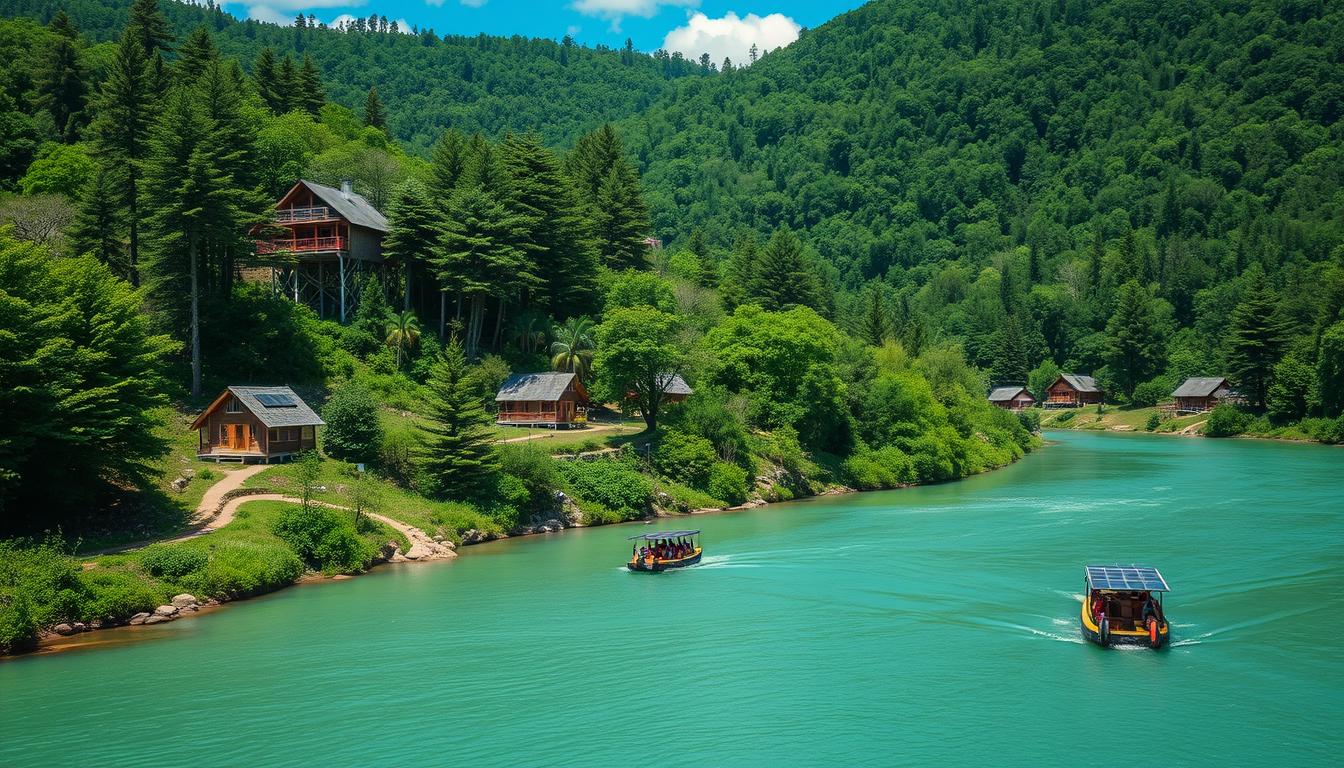Are you looking to travel in a way that’s good for the planet? The top 10 green destinations are perfect for you. These places focus on sustainable tourism and offer stunning natural beauty. You can explore lush rainforests and peaceful mountains while helping local communities and protecting nature.
Key Takeaways
- Discover the world’s top eco-friendly travel destinations that prioritize sustainability and environmental conservation.
- Explore the principles of responsible tourism and how it benefits local communities.
- Learn about the diverse range of green vacation spots, from tropical paradises to mountainous regions.
- Uncover the unique natural wonders and cultural treasures of these eco-friendly travel destinations.
- Gain insights into how you can maximize your positive impact as a sustainable traveler.
Exploring the World Through Sustainable Tourism
Sustainable tourism is becoming more popular. It encourages travelers to think about their impact on the environment and local communities. This way of traveling aims to reduce harm and offer positive experiences for everyone involved.
At the heart of sustainable tourism are key principles. These include:
- Minimizing waste and carbon footprint
- Respecting local cultures and traditions
- Supporting local businesses and economies
- Protecting natural habitats and wildlife
- Educating travelers on sustainability practices
By following these principles, eco-friendly vacations offer many benefits. For example, they can:
- Empower local economies by helping small businesses and artisans.
- Preserve cultural heritage by promoting real cultural experiences and respecting traditions.
- Protect the environment by lowering travel’s environmental impact and supporting conservation.
- Enhance the travel experience by providing unique and meaningful experiences for visitors.
As more people seek green travel, eco-friendly vacations are becoming more common. By choosing sustainable tourism, travelers can explore the world and make a positive difference.
| Principle | Benefits |
|---|---|
| Minimizing waste and carbon footprint | Reduces environmental impact and supports conservation efforts |
| Respecting local cultures and traditions | Preserves cultural heritage and provides authentic experiences |
| Supporting local businesses and economies | Empowers local communities and promotes economic development |
| Protecting natural habitats and wildlife | Ensures the long-term sustainability of ecotourism destinations |
| Educating travelers on sustainability practices | Fosters a culture of responsible travel and environmental stewardship |
“Sustainable tourism is not just about being ‘green’ – it’s about creating a better future for the places we love to visit.”
What is Eco-Friendly Travel?
Eco-friendly travel, or eco-tourism, is a way to travel that cares about the environment, culture, and local people. It aims to reduce the harm caused by travel. It also promotes green practices and supports the communities that welcome us.
Principles of Responsible Tourism
The main ideas of responsible tourism are:
- Reducing harm to the environment by using green practices, like cutting down on waste and saving energy.
- Helping local economies by working with and helping local businesses and people.
- Keeping cultural heritage alive by respecting and learning about the traditions of the host community.
- Teaching travelers about the need for sustainable tourism and how to care for the environment and culture.
Benefits of Eco-Tourism for Local Communities
Eco-tourism brings many good things to the local communities:
- It creates jobs and helps the economy by supporting small businesses and local jobs.
- It helps protect nature and wildlife by encouraging the care of the environment.
- It helps keep cultural traditions alive by promoting and valuing local heritage.
- It empowers communities by involving them in making decisions about tourism.
By following eco-friendly travel, we can make a positive difference in the places we visit. This helps these communities grow strong and sustainable for the future.
Costa Rica: A Paradise for Nature Lovers
Costa Rica is a top spot for eco-tourism, letting visitors dive into its rich Costa Rican rainforests and wildlife. It’s a leader in sustainable travel in Central America. The country works hard to keep its nature safe while giving visitors amazing experiences.
The country’s national parks and protected areas are a big draw for Costa Rica eco-tourism. You can see towering volcanoes and beautiful Pacific beaches. Costa Rica has many different ecosystems, full of plants and animals.
Explore the Corcovado National Park, a UNESCO World Heritage site. It’s one of the most diverse places on Earth. Or, trek through the Monteverde Cloud Forest Reserve. It’s a misty place full of colorful birds and special plants.
Costa Rica is also a leader in renewable energy and sustainable development. It aims to be carbon neutral by 2050. The country uses geothermal and hydroelectric power, showing it’s a green energy leader.
| Destination | Highlights | Sustainable Initiatives |
|---|---|---|
| Corcovado National Park | UNESCO World Heritage site, one of the most biodiverse places on Earth | Strict conservation measures, eco-lodges, and community-based tourism |
| Monteverde Cloud Forest Reserve | Diverse ecosystem with unique plant and animal species | Sustainable forest management, eco-tourism education programs |
| Arenal Volcano National Park | Active volcano, thermal hot springs, adventure activities | Geothermal energy production, eco-lodges, and sustainable transportation |
Costa Rica is a top choice for sustainable travel in Central America. It’s all about protecting the environment and showing off its natural beauty. Whether you want to see the Costa Rican rainforests and wildlife or learn about sustainability, Costa Rica is the place to be.
Iceland: Land of Fire and Ice
Iceland sits in the North Atlantic, a land of amazing natural wonders. It attracts eco-conscious travelers from everywhere. With its glaciers, geothermal pools, and volcanic landscapes, it offers a unique, sustainable travel experience.
Geothermal Energy and Natural Wonders
Iceland sustainable tourism shines because of its use of geothermal energy in Iceland. Icelanders use Earth’s heat to power homes, heat water, and even grow food in greenhouses.
The country’s stunning landscapes also make it great for eco-friendly travel in Iceland. You can visit the Blue Lagoon, a spa in a lava field, or explore Snaefellsjokull National Park. It’s home to a famous volcano with a glacier on top.
Travelers in Iceland can hike along the coast, see amazing waterfalls, or look for the Northern Lights. They experience a world where nature and sustainability go hand in hand.
Eco-Friendly Travel: Top 10 Green Destinations
Many travelers now want to see the world without harming the environment. Our planet has many green vacation spots around the world for those who care about the planet. We’ll look at the top 10 eco-friendly travel destinations that focus on saving the environment and supporting local communities.
- Costa Rica: Known for its rainforests, beaches, and eco-tourism, Costa Rica is a leader in sustainable travel.
- Iceland: With its stunning landscapes and renewable energy, Iceland is a unique destination for eco-conscious travelers.
- Bhutan: This country is dedicated to preserving nature and culture, making it a model for sustainable living.
- Tanzania: Home to the Serengeti and Kilimanjaro, Tanzania is committed to protecting its wildlife and landscapes.
- New Zealand: Known for its outdoor adventures and green practices, New Zealand is a top choice for eco-friendly travel.
| Destination | Key Eco-Friendly Features | Sustainable Activities |
|---|---|---|
| Costa Rica | – Extensive national park system – Renewable energy initiatives – Eco-lodges and sustainable tourism |
– Rainforest hikes – Wildlife observation – Sustainable farm visits |
| Iceland | – Geothermal energy utilization – Emphasis on renewable resources – Sustainable transportation options |
– Exploring natural hot springs – Glacier hiking – Eco-friendly sightseeing tours |
| Bhutan | – Carbon-negative country – Preservation of cultural heritage – Strict environmental regulations |
– Trekking in the Himalayas – Visiting ancient monasteries – Experiencing traditional Bhutanese cuisine |
These destinations are part of the list of eco-friendly travel destinations. They let travelers see the world while being kind to the planet. By choosing sustainable travel options, we help protect our planet’s beauty and support local communities.
Bhutan: The Kingdom of Happiness
Bhutan is a small country in the Himalayas that stands out in sustainable tourism. It’s known as the “Kingdom of Happiness.” Bhutan is dedicated to protecting the environment and preserving its culture, making it a top choice for eco-friendly travelers.
Preserving Cultural Heritage and Biodiversity
Bhutan’s culture is deeply rooted in Buddhism and its unique Himalayan traditions. The country’s dzongs (fortified monasteries) and Bhutanese architecture are well-preserved. This shows Bhutan’s strong commitment to environmental protection and its rich biodiversity.
The country offers many Bhutan eco-tourism experiences. Travelers can go on guided hikes in untouched forests. They can also visit remote villages and see the Himalayan black-necked crane in its natural habitat.
Bhutan’s sustainable travel goes beyond just nature and culture. Its Gross National Happiness philosophy puts people’s well-being first, not just economic growth. This makes Bhutan a unique and inspiring example of environmental protection.
“Bhutan is not just a country, but a state of mind – a place where happiness and harmony with nature are the ultimate goals.”
As more people look for sustainable travel in Bhutan, the country’s efforts to protect its culture and nature continue to draw visitors from all over.
Tanzania: Safaris and Conservation Efforts
Tanzania is a captivating destination for those who love nature. It offers an unparalleled chance to dive into the wonders of Tanzania’s eco-tourism. The country is known for its vast wilderness and abundant wildlife, making it a top spot for sustainable safaris.
At the heart of Tanzania’s eco-tourism are strong efforts in wildlife conservation. The country boasts many national parks and reserves. These places are full of diverse species, from African elephants and lions to leopards and black rhinos.
The Serengeti National Park is a highlight of Tanzania’s conservation work. It’s a UNESCO World Heritage Site famous for the wildebeest migration. This event attracts visitors worldwide. Tanzania ensures this wonder stays protected for future generations through careful management and responsible tourism.
Tanzania’s conservation efforts go beyond the Serengeti. The country supports community-based projects. These projects empower locals to help protect their natural heritage. They also create sustainable livelihoods and deepen the understanding of the ecosystem’s balance.
“Tanzania’s commitment to sustainable safaris and wildlife conservation is truly inspiring. By prioritizing eco-tourism and community involvement, the country sets an exemplary standard for responsible travel.”
Tanzania is a shining example for eco-friendly travel. It shows how Tanzania eco-tourism can protect nature while helping local communities. With its diverse landscapes, abundant wildlife, and innovative conservation, Tanzania is a must-visit for the eco-conscious traveler.
New Zealand: A Haven for Outdoor Adventures
New Zealand is a paradise for eco-conscious travelers. It offers stunning landscapes, diverse wildlife, and a strong focus on environmental protection. This makes it the perfect place for outdoor adventures that are both thrilling and eco-friendly.
The country boasts the Southern Alps and the Coromandel Peninsula’s pristine beaches. New Zealand eco-tourism offers endless opportunities for outdoor lovers. Hikers can explore trails through lush rainforests and past waterfalls. Kayakers can glide on serene lakes and fjords, spotting native birds and marine life.
The New Zealand government supports sustainable adventure travel with green initiatives. These ensure the country’s natural resources are protected for the future. The government has strict tourism regulations, uses renewable energy, and preserves indigenous flora and fauna.
New Zealand’s conservation efforts are a highlight of green initiatives. Visitors can enjoy eco-friendly activities like whale watching and kiwi bird viewing. Guided tours of national parks and nature reserves are also available.
New Zealand is the ultimate eco-friendly adventure destination. It’s perfect for hikers, kayakers, and nature lovers. The country offers an unforgettable experience that will inspire and invigorate you.
| Eco-Friendly Activities in New Zealand | Sustainability Initiatives |
|---|---|
|
|
“New Zealand is a world unto itself, a place of stunning and diverse natural beauty that has been carefully preserved for all to enjoy.”
Sweden: Leading the Way in Sustainability
Sweden is a global leader in sustainability and environmental care. It’s known for its eco-friendly cities and green projects. The country’s dedication to sustainable living is truly inspiring.
Eco-Friendly Cities and Green Initiatives
Stockholm, Sweden’s capital, is one of the world’s most sustainable cities. It has a great public transport system, uses renewable energy, and has lots of green spaces. This makes it a top choice for eco-friendly travel in Sweden.
Other cities like Malmö and Gothenburg are also working hard to be eco-friendly. They have their own sustainability plans and projects.
Sweden aims to be the first fossil-free welfare state by 2045. This goal includes using more renewable energy, improving transport, and reducing waste. These green initiatives in Sweden help the environment and create jobs. They also make life better for everyone in Sweden.
| Eco-Friendly City | Key Sustainability Features |
|---|---|
| Stockholm | – Extensive public transportation network – Use of renewable energy – Abundance of urban green spaces |
| Malmö | – Sustainable urban planning – Commitment to renewable energy – Focus on green infrastructure and biodiversity |
| Gothenburg | – Extensive bicycle infrastructure – Investment in renewable energy sources – Emphasis on sustainable waste management |
Sweden is a great choice for Sweden sustainable travel. Its eco-friendly cities and green projects show how to grow the economy and protect the environment. Sweden is a true leader in sustainability.
Ecuador: Exploring the Galapagos Islands
Ecuador is famous for its eco-tourism and the Galapagos Islands. It’s a top spot for those who love nature and want to travel responsibly. The country is dedicated to protecting wildlife and promoting eco-friendly tourism.
The Galapagos Islands are a UNESCO World Heritage Site. They are full of wildlife, like the Galapagos tortoise and marine iguanas. By traveling sustainably, visitors can see nature’s wonders and help protect the environment.
- Observe the unique fauna and flora of the Galapagos Islands, including the iconic Galapagos tortoise and marine iguanas.
- Engage in eco-friendly activities such as snorkeling, hiking, and kayaking to experience the islands’ natural beauty.
- Support local conservation efforts and learn about the importance of wildlife conservation in Ecuador.
There’s more to Ecuador than the Galapagos. The country is also home to the Amazon rainforest and the Andes Mountains. Ecuador works hard to protect its nature through eco-tourism and conservation.
“Ecuador’s Galapagos Islands are a true wonder of the world, where visitors can witness the incredible diversity of life and the importance of conservation efforts.” – Jane Doe, Eco-Tourism Expert
Traveling sustainably in Ecuador and the Galapagos Islands helps protect these amazing places. It also supports local communities. Ecuador’s focus on eco-friendly tourism makes it a great choice for those who care about the planet.
Nepal: Trekking in the Himalayas
Nepal is a top spot for eco-friendly travelers. Its stunning Himalayan views and rich culture make it perfect for sustainable trekking. The country works hard to help local communities and keep nature safe.
Sustainable Tourism and Community Empowerment
Nepal’s eco-tourism is growing fast, focusing on green trekking in the Himalayas. It teams up with local groups to offer tourism that helps the environment and people. Visitors can enjoy amazing trails while supporting projects that protect nature and help locals financially.
- Sustainable trekking routes that minimize environmental impact
- Eco-lodges and homestays that provide authentic cultural experiences
- Community-led conservation projects to safeguard natural habitats
Nepal’s success in eco-tourism shows its dedication to nature and people. It’s a place where travelers can have a meaningful and responsible adventure in the Himalayas.
| Benefit | Impact |
|---|---|
| Environmental Conservation | Reduced waste, protected ecosystems, and preserved biodiversity |
| Economic Opportunities | Increased income for local communities, job creation, and skill development |
| Cultural Preservation | Safeguarding traditional practices, arts, and heritage sites |
Nepal is a leader in eco-friendly trekking in the Himalayas. It shows how tourism can help both the environment and people. Travelers can make a difference on their journey to this incredible place.
Conclusion
The world is full of eco-friendly travel spots where you can see nature’s beauty and help the planet. Places like Costa Rica’s rainforests and Iceland’s geothermal areas are great examples. They show how important it is to travel green and support local communities.
Eco-tourism is becoming more popular as people want to travel in a way that’s good for the environment. Destinations that focus on being green are likely to do well. This trend is helping to protect our planet and support local people.
We can all help make travel more sustainable. Whether you’re in New Zealand, Nepal, or the Galapagos, eco-friendly travel is a way to see the world. It lets us connect with nature while keeping it beautiful for the future.
FAQ
What is eco-friendly travel?
Eco-friendly travel, or sustainable tourism, focuses on protecting the environment and helping local communities. It aims to reduce carbon footprints and support responsible tourism.
What are the principles of responsible tourism?
Responsible tourism includes reducing environmental harm, preserving culture, and supporting local economies. It also empowers communities. Eco-travelers use renewable energy, reduce waste, and respect local customs.
What are the benefits of eco-tourism for local communities?
Eco-tourism creates jobs, boosts local economies, and protects natural resources. It supports community-based tourism, empowering locals and ensuring fair benefits from tourism.
Why is Costa Rica a top destination for eco-friendly travel?
Costa Rica is known for its green efforts and sustainable tourism. Its rainforests, wildlife, and renewable energy make it perfect for eco-conscious travelers.
How does Iceland’s use of geothermal energy contribute to its eco-friendly tourism?
Iceland’s geothermal energy powers its electricity and heating. This makes it a great place for eco-friendly travel, allowing visitors to see natural wonders while being green.
What makes Bhutan a leading destination for sustainable travel?
Bhutan is famous for its green policies and cultural preservation. Its “Gross National Happiness” approach makes it a top choice for eco-friendly travelers.
How does Tanzania’s conservation efforts benefit eco-tourism?
Tanzania’s wildlife and landscapes are key to its eco-tourism. Conservation efforts, like anti-poaching, protect its ecosystems and help local communities.
What makes New Zealand a haven for outdoor enthusiasts interested in sustainable travel?
New Zealand’s green policies and stunning landscapes are perfect for eco-conscious adventurers. It offers many eco-friendly activities, like hiking and kayaking, while focusing on sustainable tourism.
How is Sweden leading the way in sustainable travel?
Sweden is a leader in green policies and tourism. Its eco-friendly cities, renewable energy, and sustainable development make it a top choice for eco-travelers.
Why is Ecuador, particularly the Galapagos Islands, a prime destination for eco-tourism?
Ecuador, especially the Galapagos, is known for its unique wildlife and conservation. Its sustainable tourism and natural resource protection attract eco-conscious travelers.
How does Nepal’s sustainable tourism initiatives benefit local communities?
Nepal’s Himalayas and culture draw many eco-conscious travelers. Its sustainable tourism, like community projects, preserves the environment and empowers locals, ensuring tourism benefits are fair.








